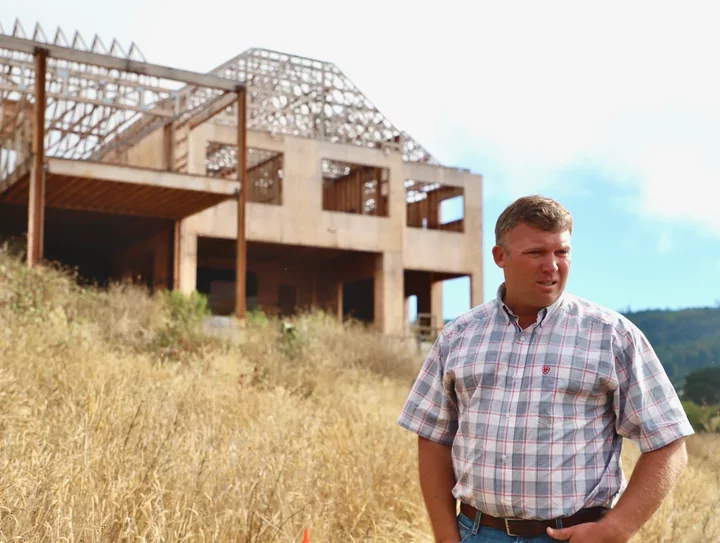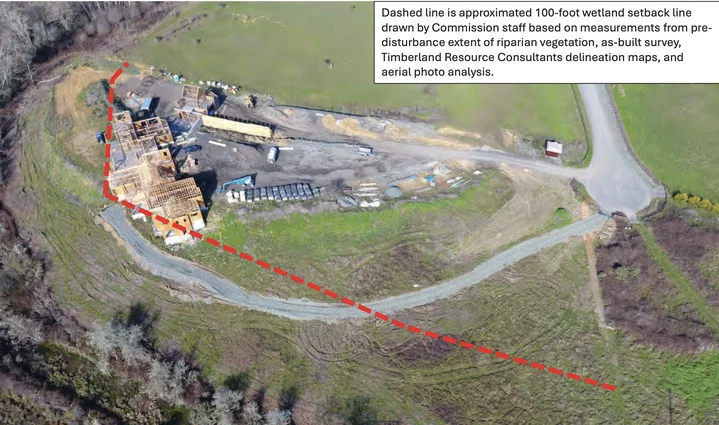Developer and business owner Travis Schneider stands on a slope beneath his partially built dream home in October of 2022. | File photo by Andrew Goff.
###
Travis Schneider’s permitting woes continue.
More than eight months after the local developer agreed to tear down his partially built, permit-violating family dream mansion in the Walker Point subdivision northeast of Eureka, the California Coastal Commission today found “substantial issues” with the county-approved demolition and remediation plan and took over jurisdiction of the project.
In a hearing that lasted only about two and a half minutes, commission staff explained that Humboldt County had authorized the demolition and removal of Schneider’s half-built 21,000-square-foot residential structure, along with a driveway and retaining walls, plus removal of 15,000 cubic yards of fill material that was illegally trucked onto the property.
To recap how we got here, Schneider was only permitted to build an 8,000-square-foot home on a pair of parcels overlooking the Fay Slough Wildlife Area. The county issued a stop-work order in December of 2021 in response to unauthorized grading and ground disturbance in prohibited areas with known sensitive resources.
Further investigation revealed a host of permit violations: Not only was the framed-up residential structure more than two and a half times larger than permitted, but it had been built in a location that didn’t match the final site plans. A corner of the house extended into a 100-foot setback from an environmentally sensitive habitat area (ESHA).
Schneider had also lain down an un-permitted temporary access road within designated wetland buffer areas, and he’d used heavy equipment to conduct major vegetation removal within protected wetlands and other environmentally sensitive areas.
Despite subsequent efforts to resolve the permit violations — including consultations with the Wiyot Tribe, the Blue Lake Rancheria and the Bear River Band of the Rohnerville Rancheria regarding a designated archeological site on the property — county staff determined that there was simply no way for the residence to be permitted.
Last April, Schneider, who has since moved out of state with his family, agreed to apply for modifications to his Coastal Development Permit so he could tear down the home and remediate the property to its pre-construction condition. He also sought a lot-line adjustment and agreed to convey one of the two redrawn parcels to a land-holding agency for the benefit of the three Wiyot-area tribes.
After consulting with the tribes and Coastal Commission staff, the county granted the permit modification request, subject to various conditions.
However, in today’s brief Coastal Commission hearing, agency staff argued that the plan doesn’t adequately protect archaeological and tribal cultural resources or the nearby ESHA. Staff further suggested that the demolition and remediation plan raises substantial issues with the California Coastal Act and Humboldt County’s Local Coastal Plan.
Finally, staff recommended that the Coastal Commission take over jurisdiction of the Coastal Development Permit application.
Meanwhile, professional cultural resources consultant Janet P. Eidsness submitted a letter on behalf of the Wiyot Tribe urging the commission to determine that there are substantial issues with the county-approved plan and requesting a number of new conditions, including a requirement for more participation from tribes and consultation with a qualified cultural resources manager.
After staff’s brief presentation, Commission Chair Caryl Hart asked her colleagues whether three or more of them wished to dispute the finding of “substantial issues” with the permit. No one piped up, so Hart announced that substantial issues had been found.
The Coastal Commission will hold a new hearing about Coastal Development Permit permit at a later date.
Drone footage from the Blue Lake Rancheria, from 2022, shows that Schneider’s construction extended beyond the100-foot wetland setback line.
PREVIOUSLY:
- Heated Meeting Sparks Accusations of Dishonesty and Discrimination, Opening Rift Between Tribes and Humboldt County Planning Commission
- Despite Silence From Tribes, Mega-Home Builder Optimistic Ahead of Tonight’s Continued Planning Commission Hearing to Address Permit Violation Fallout
- After Rebukes and Apologies for Bongio’s ‘Disrespectful’ Comments, Planning Commission Defers Decision on Mega-Home Permits
- County Supes to Consider Censure of Planning Commission Chair Alan Bongio for Inappropriate Conduct
- Bohn Makes the Motion, Supes Unanimously Censure Bongio for Racist Remarks, Move to Remove Him as Chair of Planning Commission
- A Tour Through the Half-Built Dream Mansion of Travis Schneider, Who Remains Hopeful Amid Mounting Permit Problems
- Alan Bongio, Embattled Humboldt County Planning Commissioner, Resigns
- Planning Commission Set to Rescind Permit for Controversial Schneider Home as Developer Prepares to Tear it Down, Remediate Damage to Property
- Schneider Offers Emotional Apology as Planning Commission Approves Tear-Down of His Permit-Violating, Half-Built Family Dream Home


CLICK TO MANAGE